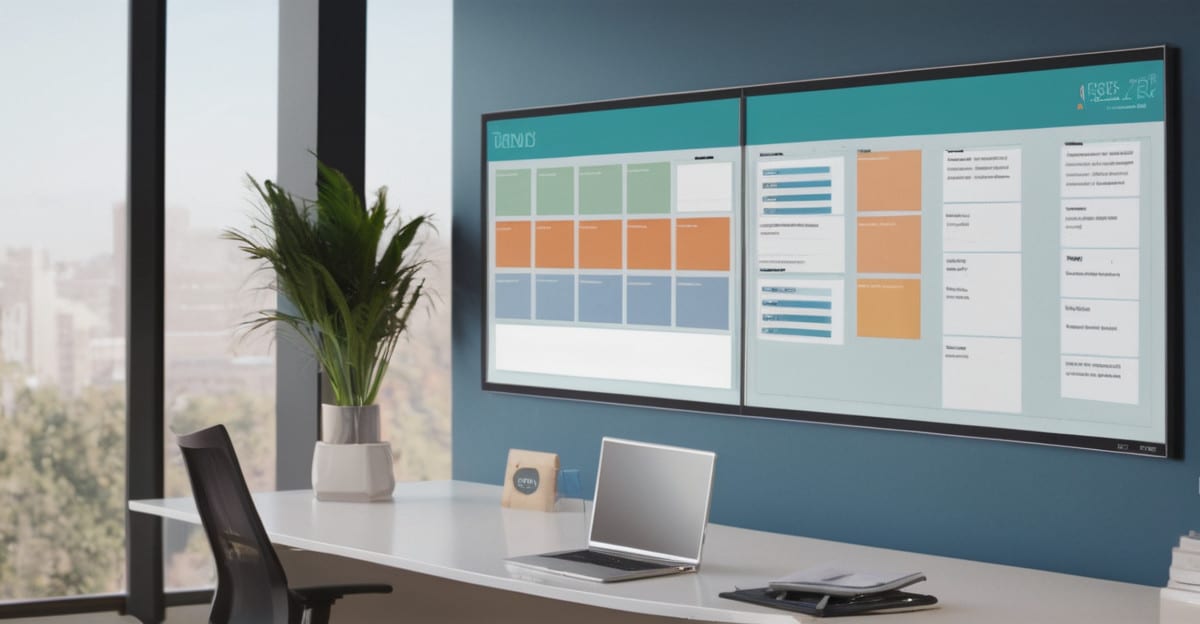
Introduction
In the current digital era, managing remote employees has become more and more crucial. With 2024 approaching, there will be an even greater demand for efficient solutions for managing remote teams. You may increase efficiency and optimize remote operations by reading this article, which examines the top tools for managing remote workers in 2024.
1. Slack
Slack is a powerful communication tool that has revolutionized the way remote teams interact. It offers real-time messaging, video calls, and file sharing, making collaboration seamless. The platform also integrates with various productivity apps, ensuring that all tools are accessible in one place. With Slack, remote employees can stay connected and engaged, regardless of their location.
Slack’s user-friendly interface and robust features make it a top choice for managing remote teams. It supports channels for different projects, direct messaging for one-on-one conversations, and group calls for team meetings. Additionally, Slack’s search functionality allows users to quickly find past conversations and files, ensuring that important information is never lost.
In 2024, Slack continues to be a leader in remote team communication, offering new features and integrations to further enhance its capabilities. Whether you’re managing a small team or a large organization, Slack provides the tools needed to keep everyone on the same page.

2. Trello
Trello is a versatile project management tool that helps remote teams stay organized. It uses boards, lists, and cards to break down tasks and projects, making it easy to track progress and deadlines. Trello’s visual interface is intuitive, allowing team members to quickly see what needs to be done and who is responsible for each task.
One of Trello’s key strengths is its flexibility. It can be customized to fit the unique needs of any team, with options for adding due dates, attachments, and checklists to cards. Trello also integrates with various other tools, such as Slack, Google Drive, and Jira, ensuring that all project-related information is easily accessible.
As we move into 2024, Trello continues to be a popular choice for remote project management. Its ease of use, combined with powerful features, makes it an essential tool for teams looking to stay on top of their work and collaborate effectively.
3. Zoom
Zoom has become synonymous with virtual meetings, offering reliable video conferencing solutions for remote teams. It supports high-quality video and audio calls, webinars, and screen sharing, making it easy for remote employees to connect and collaborate. Zoom’s breakout rooms feature also allows for smaller group discussions within larger meetings, enhancing team engagement.
In addition to its core features, Zoom offers a range of advanced options, such as virtual backgrounds, meeting recording, and integration with calendars and other productivity tools. These features help ensure that meetings are productive and that important discussions are documented for future reference.
In 2024, Zoom remains a top choice for remote team communication. Its user-friendly interface and reliable performance make it an essential tool for managing remote employees and keeping teams connected.

4. Asana
Asana is a comprehensive project management tool designed to help remote teams stay organized and on track. It offers a range of features, including task assignments, deadlines, project timelines, and progress tracking. Asana’s visual interface makes it easy to see the status of projects and identify any potential bottlenecks.
One of Asana’s standout features is its ability to create dependencies between tasks, ensuring that team members know what needs to be completed before they can move on to the next step. Asana also integrates with various other tools, such as Slack, Google Drive, and Microsoft Teams, making it easy to keep all project-related information in one place.
As we move into 2024, Asana continues to be a popular choice for remote project management. Its robust features and ease of use make it an essential tool for teams looking to stay organized and productive.
5. Microsoft Teams
Microsoft Teams is a feature-rich platform for remote work that facilitates communication and teamwork. Numerous capabilities are available, such as file sharing, video calls, chat, and interaction with Microsoft Office applications. This facilitates communication and collaboration on papers and projects for remote teams.
Microsoft Teams’ ability to integrate with the Microsoft ecosystem is one of its main advantages. This enables immediate platform access and editing of Word, Excel, and PowerPoint documents by users. Additionally, Teams allows for third-party app integrations, which makes it a flexible solution for managing remote work.
Microsoft Teams is still the best option for remote team collaboration and communication in 2024. Because of its many capabilities and easy Microsoft Office integration, it’s a vital tool for managing remote workers.
6. Monday.com
A versatile project management platform called Monday.com keeps remote teams productive and organized. Numerous features are available, such as task delegation, deadlines, progress monitoring, and timeframes. The platform’s graphical user interface makes it simple to view project statuses and spot possible problems.
The flexibility of Monday.com’s processes to meet the particular requirements of any team is one of its best qualities. Custom boards, columns, and automations can be made by users to tailor the platform to their own workflow. Additionally, Monday.com interacts with a number of other apps, like Zoom, Google Drive, and Slack, making it simple to keep all project-related data in one location.
Monday.com is still a well-liked option for remote project management as we approach 2024. It is a vital tool for teams trying to remain on top of their work and cooperate efficiently because of its versatility and strong features.
7. Toggl
Remote teams may keep track of how much time they spend on various activities and projects by using Toggl, a time tracking application. Managers who want to understand production levels and pinpoint areas for development may find this especially helpful. Toggl’s user-friendly layout makes it simple for team members to keep track of their time.
Toggl’s reporting capabilities are one of its main advantages. For the purpose of charging clients or evaluating team performance, users can create comprehensive reports on how their time is being spent. Toggl may be easily integrated into existing processes by integrating with a number of different apps, including Trello, Asana, and Slack.
Toggl is still the best option for measuring time remotely in 2024. It is a crucial tool for managing remote workers and making sure time is spent efficiently because of its robust reporting tools and ease of use.
8. Basecamp
Basecamp is a project management and team collaboration application made to support productive communication and organization among remote teams. A variety of functions are available, such as real-time chat, message boards, file sharing, and to-do lists. Maintaining all project-related data in one location is simple with Basecamp’s all-in-one platform.
Basecamp’s simplicity is one of its best qualities. The platform has an easy-to-use interface that is clear and simple to utilize. Because of this, it’s a fantastic option for teams who wish to start working right away without having a challenging learning curve. Basecamp facilitates seamless team collaboration by integrating with multiple additional tools including Zoom, Google Drive, and Slack.
Basecamp is still a well-liked option for remote project management as we approach 2024. Its all-in-one platform and simplicity of use make it a vital tool for teams trying to maintain productivity and organization.
9. GitHub
Version control and collaboration tools for software development are offered by the site GitHub. It is especially well-liked by remote development teams since it provides capabilities for collaboration, code hosting, and review. Git, GitHub’s robust version control system, enables teams to work together on code, monitor changes, and oversee several project iterations.
The collaboration features of GitHub are one of its main advantages. Users may easily merge updates, debate changes, and create pull requests for code reviews. Additionally, GitHub is easily integrated into existing workflows because to its many integrations with other programs, including Jira, Trello, and Slack.
GitHub is still the best option for remote software development teams in 2024. Its powerful collaboration and version control tools make it a vital tool for managing distant development projects.
10. Hubstaff
For remote teams, Hubstaff is a time-tracking and productivity-monitoring solution. With its capabilities, which include activity tracking, project management, and time tracking, managers may better understand how their staff is spending their time. Managers can easily assess productivity and team members can easily track their work hours thanks to Hubstaff’s user-friendly interface.
Hubstaff’s ability to monitor activity is one of its best qualities. In addition to tracking activity levels and generating comprehensive information on time spent, the platform has the ability to take screenshots. Managers that want to make sure their remote workers are remaining productive and identify areas for development may find this to be especially helpful.
Hubstaff is still a well-liked option for remote time tracking and productivity monitoring as we approach 2024. Because of its robust capabilities and user-friendly interface, it’s a crucial tool for overseeing remote workers and making sure their time is spent efficiently.
Conclusion
In conclusion, having the appropriate tools is essential for managing remote workers successfully. In 2024, Slack, Trello, Zoom, Asana, Microsoft Teams, Monday.com, Toggl, Basecamp, GitHub, and Hubstaff are among the top tools for managing remote workers. These programs all have special characteristics that can improve output and simplify remote work. It is possible to guarantee that your remote workers remain connected, well-organized, and productive by selecting the appropriate technologies for your team.






